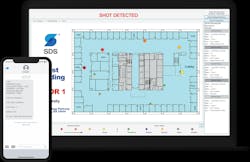This article originally appeared in the June 2024 issue of Security Business magazine. Don’t forget to mention Security Business magazine on LinkedIn and @SecBusinessMag on Twitter if you share it.
According to The Violence Project, the workplace is the most common site for mass shootings, followed by retail, restaurants, and bars. In the United States in 2020, 392 workers were homicide victims, based on a report from the U.S. Centers for Disease Control and Prevention. In all its forms, workplace violence is a problem that impacts more than one million Americans every year.
This startling data has businesses of all types, from commercial offices and healthcare facilities to retailers and educational institutions, turning to more proactive approaches to combat workplace violence. As they are implementing new policies, integrators can help with technologies that can help identify threats before they happen and prioritize capabilities that will enable first responders to respond quickly.
The role of the security systems integrator to assist customers with facility-wide safety and security continues to evolve. It is important for integrators to look beyond being a specifier of hardware or software and to embrace the partnership role that needs to take place to help organizations of all types address workplace violence and active shooter issues.
As end-users pursue a multi-layered approach to address workplace violence issues to keep employees and customers safe, it is important to also define the role of the systems integrator. How, as stewards of keeping people safe, can security integrators help their clients implement a security program that addresses workplace violence and active shooter concerns?
The role of the security systems integrator to assist customers with facility-wide safety and security continues to evolve. It is important for integrators to look beyond being a specifier of hardware or software and to embrace the partnership role that needs to take place to help organizations of all types address workplace violence and active shooter issues. Here are five ways to achieve that goal:
1. Review workplace security and safety policies.
Security integrators should work closely with customers to understand their security and safety policies that currently exist and to identify gaps that need to be addressed.
For example: Are there policies in place to prevent unauthorized entry by a disgruntled former employee? Are employees allowed to bring firearms or other weapons into work?
These policies can take many different forms, from prohibiting employees from sharing access control credentials with other users, requiring that visitors first check in with reception before being given access to a facility, and the enforcement of weapons bans on company property.
Other examples: Does the place of business have a zero-tolerance policy for violence in the workplace? Is there a “see something-say something” policy in place that protects a reporter’s identity? These policies can clearly outline the expectations for employees, contractors, and customers, as well as the repercussions when an individual breaks this policy.
2. Assess facility security needs.
As with any security project, it is important to understand a facility's unique security needs. A retail facility may require more surveillance cameras to identify shoplifting, while an office or school setting may need an access control system that can keep entrances secure and restrict access to only individuals who are authorized to enter. Public facilities – such as shopping malls, convention centers, hospitals, or university campuses – might require real-time alerting systems that can notify security staff in the event of an incident, such as a gunshot or the formation of an angry crowd.
By assessing which systems are currently in place and how each technology is being leveraged, security integrators can identify gaps and provide guidance on areas where security needs to be improved.
When it comes to reducing workplace violence issues from disgruntled former employees, facilities need to make sure they have an access control system in place that can quickly revoke privileges and alert security personnel should a former employee attempt to gain access to a secure building.
3. Invest in and embrace emerging technologies.
With every security program, technology remains an important foundation that can help prevent or mitigate a workplace violence incident and quickly report an incident should one occur. In addition to the core security technologies that many businesses already invest in, from surveillance and access control to intrusion alarm systems and fire alarms, newer technologies are being leveraged that can automatically alert security personnel or the local police department about an active shooter incident.
Security integrators who incorporate gunshot detection into proposals or RFPs for video analytics or intelligent access control can demonstrate to clients that they are forward-thinking and have made internal investments to stay ahead of competitors on the cutting-edge technologies available.
4. Identify grant funding to support workplace safety.
Funding can enable customers to invest in technologies to reduce workplace violence issues and respond to active shooter incidents that may not be possible otherwise. Workplace safety has been prioritized by the federal government, with increased grant funding and legislative initiatives to support investments in both training and security technologies. For example, in fiscal year 2023, FEMA provided $305 million for facility hardening and other security enhancements for non-profits that are at risk for violent attacks.
The recently approved California Senate Bill 553 – which extends workplace violence protections to businesses beyond the healthcare space – does not yet include funding for investments in technology; however, it includes heightened employee protection requirements that employers must take steps to enact. Specifically, by July 1, 2024, certain employers in California must establish, implement, and maintain a “Workplace Violence Plan,” which should include security technologies, policies, and procedures for their use in the prevention and mitigation of workplace violence.
As an integrator, becoming a trusted partner means helping to identify available grant funding, along with assisting customers with the grant application process. If the grants landscape seems daunting, integrators should ask manufacturer partners if they have grant assistance services that can be leveraged by working together with an end-user.
5. Leverage government-provided resources.
Security integrators do not need to be experts in threat assessment, workplace violence, and/or emergency action planning to be a part of the overall risk mitigation planning with clients. There are many free resources available that can help prompt the right questions, including templates and policy guides from the U.S. Department of Labor, the Occupational Health and Safety Administration (OSHA), the Department of Homeland Security (DHS), and the Cybersecurity and Infrastructure Security Agency (CISA).
Technology Close-Up: Gunshot Detection Systems
Considering the volume of active shooter incidents taking place in schools and workplaces in America, gunshot detection technology has garnered a vastly heightened public interest.
Gunshot detection systems alert first responders faster than any current method – enabling them to get to the scene sooner, armed with critical incident details, including vital location information, such as where in the building the incident is happening.
Both speed and accuracy are paramount. The average length of an active shooter incident is around five minutes, with an average of one death occurring every 5 to 15 seconds. Ultimately, any facility that experiences an active shooter incident needs to be able to rely on the gunshot detection system to automate the alerting process and push real-time data and updates to first responders.
For integrators, an additional benefit of gunshot detection technology is that it can provide a recurring revenue stream, in the form of regular maintenance and testing of the sensors – as gunshot detection systems should be tested at least once a year like fire alarm systems.
Integrators who install gunshot detection technology should take a layered approach, also leveraging the benefits of other technologies. As part of an integrated technology program, gunshot detection systems provide a crucial layer of detection and notification capabilities to instantly alert staff if a gunshot has been detected and to implement additional security measures if necessary.
About the Author

James Reno
James Reno is Vice President of Commercial Sales for Alarm.com and Shooter Detection Systems.

